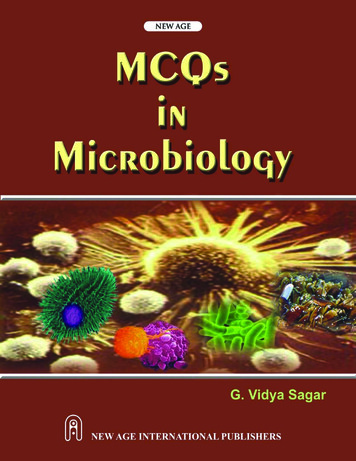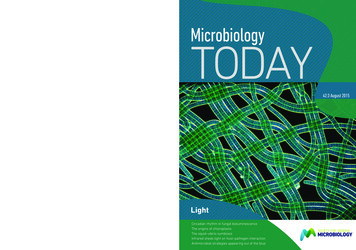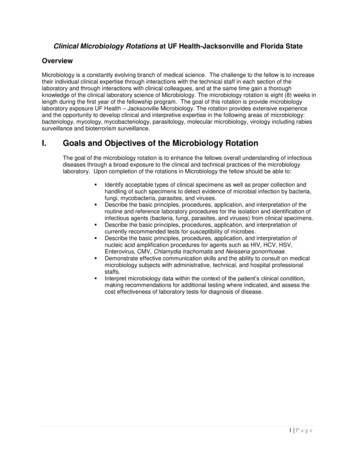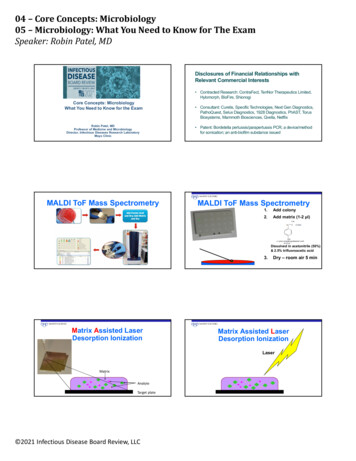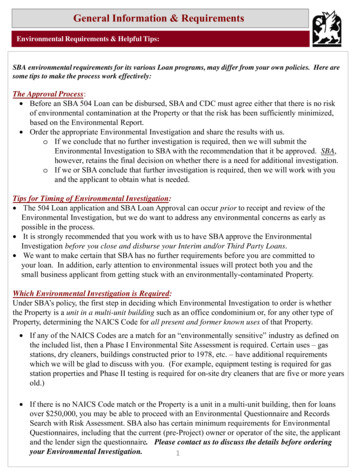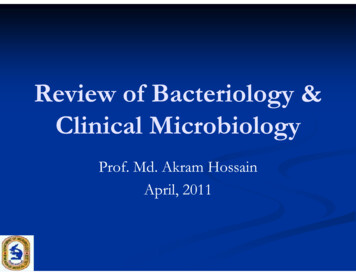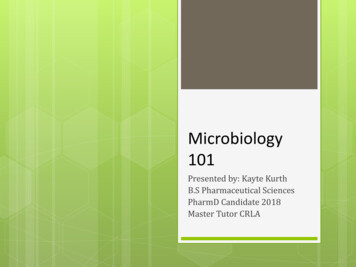
Transcription
Environmental MicrobiologySecond EditionPrelims-P370519.indd i7/22/2008 6:27:18 PM
Prelims-P370519.indd ii7/22/2008 6:27:18 PM
EnvironmentalMicrobiologySecond EditionRaina M. MaierDepartment of Soil, Water and Environmental ScienceUniversity of ArizonaTucson, ArizonaIan L. PepperDepartment of Soil, Water and Environmental ScienceUniversity of ArizonaTucson, ArizonaCharles P. GerbaDepartment of Soil, Water and Environmental ScienceUniversity of ArizonaTucson, ArizonaAMSTERDAM BOSTON HEIDELBERG LONDON NEW YORK OXFORDPARIS SAN DIEGO SAN FRANCISCO SINGAPORE SYDNEY TOKYOAcademic Press is an imprint of ElsevierPrelims-P370519.indd iii7/22/2008 6:27:18 PM
Cover photos:(left) Adenovirus, copyright Russell Kightley Media, with permission. (middle) A fluorescentin situ hybridization (FISH) image of bacterial colonization of a Buchloe dactyloides (buffalograss)root grown in mine tailings with 5% compost. The universal probe EUB338-mix labeled with Cy5was used to label the bacteria and the image was taken with a Zeiss confocal scanning laser microscope.Image courtesy Sadie L. Iverson, University of Arizona, Tucson, AZ. (right) Prosopis juliflora(mesquite) root colonized by the mycorrhizal fungus Glomus intraradices, showing spores and hyphae.The sample was stained with trypan blue and imaged with at 40X. Image courtesy Fernando A.Solis-DominguezAcademic Press is an imprint of Elsevier30 Corporate Drive, Suite 400, Burlington, MA 01803, USA525 B Street, Suite 1900, San Diego, California 92101-4495, USA84 Theobald’s Road, London WC1X 8RR, UKCopyright 2009, Elsevier Inc. All rights reserved.No part of this publication may be reproduced or transmitted in any form or by any means, electronic ormechanical, including photocopy, recording, or any information storage and retrieval system,without permission in writing from the publisher.Permissions may be sought directly from Elsevier’s Science & Technology Rights Department inOxford, UK: phone: ( 44) 1865 843830, fax: ( 44) 1865 853333, E-mail: permissions@elsevier.com.You may also complete your request online via the Elsevier homepage (http://elsevier.com), by selecting“Support & Contact” then “Copyright and Permission” and then “Obtaining Permissions.”Library of Congress Cataloging-in-Publication DataApplication SubmittedBritish Library Cataloguing-in-Publication DataA catalogue record for this book is available from the British Library.ISBN: 978-0-12-370519-8For information on all Academic Press publicationsvisit our Web site at www.elsevierdirect.comTypeset by Charon Tec Ltd., A Macmillan Company. (www.macmillansolutions.com)Printed in China08 09 109Prelims-P370519.indd iv876543217/22/2008 6:27:19 PM
It takes a village—thanks to my family, especially Mom, Dad and my daughter Claire.Raina M. MaierThis book is dedicated to microbes—they’re everywhere and I believe they are smarter than we think.Ian L. PepperThis book is dedicated to my wife and sons Peter and Phillip for all their support.Charles P. GerbaDED-P370519.indd v7/21/2008 12:15:04 PM
DED-P370519.indd vi7/21/2008 12:15:04 PM
ContentsPrefaceAcknowledgmentsThe AuthorsContributing AuthorsxvxviixixxxiPart IReview of Basic MicrobiologicalConcepts1. Introduction to EnvironmentalMicrobiologyIntroductionAn Historical PerspectiveModern Environmental MicrobiologyPurpose and Organization of This Text33672. MicroorganismsTimberley M. Roane, Kelly A. Reynolds, Raina M. Maierand Ian L. Pepper2.1 Classification of Organisms2.2 Eubacteria2.2.1 Cell Envelope2.2.2 Cytoplasm2.2.3 Glycocalyx2.2.4 Appendages2.2.5 Endospores2.2.6 Information Transfer2.2.7 Metabolism2.3 The Archaea2.3.1 Archaean Habitats2.3.2 Archaean Function2.4 Fungi2.4.1 Fungal Structure2.4.2 Fungal Diversity2.4.3 Ecological Considerations2.5 Slime Molds2.6 Protozoa2.6.1 Structure and Function2.6.2 Physiological and EcologicalConsiderations26272728293032333333343. Bacterial GrowthRaina M. Maier, Ian L. Pepper and Charles P. Gerba1.11.21.31.42.7 Algae2.7.1 Cell Structure2.7.2 Physiological and EcologicalConsiderations2.8 Viruses2.8.1 Infective Nature of Viruses2.8.2 Procaryotic Viruses2.8.3 Eucaryotic Viruses2.9 Other Biological Entities2.9.1 Viroids2.9.2 252526Raina M. Maier3.1 Growth in Pure Culture in a Flask3.1.1 The Lag Phase3.1.2 The Exponential Phase3.1.3 The Stationary Phase3.1.4 The Death Phase3.1.5 Effect of Substrate Concentrationon Growth3.2 Continuous Culture3.3 Growth in the Environment3.3.1 The Lag Phase3.3.2 The Exponential Phase3.3.3 The Stationary and Death Phases3.4 Mass Balance of Growth3.4.1 Aerobic Conditions3.4.2 Anaerobic ConditionsQuestions and ProblemsReferences and Recommended Readings38383940414244464747474950525354Part IIMicrobial Environments4. Earth EnvironmentsRaina M. Maier and Ian L. Pepper4.1 Earth’s Living Skin4.2 Physicochemical Characteristics of theEarth Environment4.2.1 Earth Environments575858viiPrelims2-P370519.indd vii7/22/2008 6:26:32 PM
viiiContents4.34.44.54.64.2.2 The Solid Phase4.2.3 The Liquid Phase4.2.4 Soil AtmosphereSoil as a Microbial Environment4.3.1 Biotic Stresses4.3.2 Abiotic StressesMicroorganisms in Surface Soils4.4.1 Bacteria4.4.2 Actinomycetes4.4.3 Fungi4.4.4 Algae4.4.5 ProtozoaDistribution of Microorganisms in SoilMicroorganisms in SubsurfaceEnvironments4.6.1 Microorganisms in ShallowSubsurface Environments4.6.2 Microorganisms in Deep SubsurfaceEnvironmentsQuestions and ProblemsReferences and Recommended Reading5967697070707171717374747576777781815. AeromicrobiologyIan L. Pepper and Scot E. Dowd5.15.25.35.45.55.6IntroductionImportant Airborne PathogensImportant Airborne ToxinsAerosolsNature of BioaerosolsAeromicrobiological Pathway5.6.1 Launching5.6.2 Transport5.6.3 Deposition5.7 Microbial Survival in the Air5.7.1 Relative Humidity5.7.2 Temperature5.7.3 Radiation5.7.4 Oxygen, OAFs, and Ions5.8 Extramural Aeromicrobiology5.8.1 Agriculture5.8.2 Waste Disposal5.9 Intramural Aeromicrobiology5.9.1 Buildings5.9.2 Public Health5.9.3 Hospitals and Laboratories5.10 Bioaerosol Control5.10.1 Ventilation5.10.2 Filtration5.10.3 Biocidal Control5.10.4 Isolation5.11 Biosafety in the Laboratory5.11.1 Biological Safety Cabinets5.11.2 Biosafety LaboratoriesPrelims2-P370519.indd 9797989898100Questions and ProblemsReferences and Recommended Readings1011016. Aquatic EnvironmentsTodd R. Sandrin, Scot E. Dowd, David C. Hermanand Raina M. Maier6.1 Introduction6.2 Microbial Habitats in the AquaticEnvironment6.2.1 Planktonic Environment6.2.2 Benthic Habitat6.2.3 Microbial Mats6.2.4 Biofilms6.3 Aquatic Environments6.3.1 Freshwater Environments6.3.2 Brackish Water6.3.3 Marine Water6.3.4 Subterranean Water6.4 Aquatic Microbes in the News6.4.1 Shotgun Sequencing RevealsSecrets about the Sargasso Sea6.4.2 Aquatic Microbes: Food for theFutureQuestions and ProblemsReferences and Recommended 1201207. Extreme EnvironmentsRaina M. Maier7.1 Low Temperature Environments7.1.1 McMurdo Dry Valleys, Antarctica7.2 High Temperature Environments7.2.1 Geothermal Hot Springs7.3 Desiccation and UV Stress7.3.1 The Atacama Desert, Chile7.4 Environments Based on Chemoautotrophy7.4.1 Deep-Sea Hydrothermal Vents7.5 Acidic Environments7.5.1 Acid Mine DrainageQuestions and 3134Part IIIDetection, Enumeration, andIdentification8. Environmental Sample Collectionand ProcessingIan L. Pepper, Charles P. Gerba and Raina M. Maier8.1 Soils and Sediments8.1.1 Sampling Strategies and Methodsfor Surface Soils1371387/22/2008 6:26:33 PM
ixContents8.1.2Sampling Strategies and Methodsfor the SubsurfaceSample Processing and Storage8.1.38.2 Water8.2.1 Sampling Strategies and Methodsfor Water8.2.2 Processing Water Samples for VirusAnalysis8.2.3 Processing Water Samples forDetection of Bacteria8.2.4 Processing Water Samples forDetection of Protozoan Parasites8.3 Air8.3.1 Sampling Devices for theCollection of Air Samples8.4 Detection of Microorganisms on FomitesQuestions and ProblemsReferences and 3154154Microscopic TechniquesTimberley M. Roane, Ian L. Pepper andRaina M. Maier9.1 History of Microscopy9.2 Theory of Microscopy9.3 Visible Light Microscopy9.3.1 Types of Light Microscopy9.3.2 Sample Preparation9.4 Fluorescence Microscopy9.4.1 Direct Counts9.4.2 Fluorescent Immunolabeling9.4.3 Fluorescent In Situ Hybridization9.4.4 Confocal Laser ScanningMicroscopy9.4.5 Flow Cytometry9.5 Electron Microscopy9.5.1 Scanning Electron Microscopy9.5.2 Transmission Electron Microscopy9.5.3 Elemental Analysis9.6 Scanning Probe Microscopy9.6.1 Atomic Force Microscopy9.7 ImagingQuestions and 716716716917017117117117117210. Cultural MethodsIan L. Pepper and Charles P. Gerba10.1 Cultural Methods for Isolation andEnumeration of Bacteria10.1.1 Enumeration and IsolationTechniques10.1.2 Plating Methods10.1.3 Most Probable Number TechniquePrelims2-P370519.indd ix17317317417510.2 Culture Media for Bacteria10.2.1 General Media Used forCulturing Bacteria10.2.2 New Approaches to EnhancedCultivation of Soil Bacteria10.3 Cultural Methods for Fungi10.4 Cultural Methods for Algae andCyanobacteria10.5 Cell Culture–Based Detection Methodsfor VirusesQuestions and ProblemsReferences and RecommendedReadings17617618318418518618818811. Physiological MethodsTodd R. Sandrin, David C. Herman andRaina M. Maier11.1 Introduction11.2 Measuring Microbial Activity inPure Culture11.2.1 Substrate Utilization11.2.2 Terminal Electron Acceptors11.2.3 Cell Mass11.2.4 Carbon Dioxide Evolution11.3 Choosing the Appropriate ActivityMeasurement for EnvironmentalSamples11.4 Carbon Respiration11.4.1 Measurement of RespiratoryGases, CO2 and O2, in Laboratoryand Field Studies11.4.2 The Application of RespirationMeasurements in EnvironmentalMicrobiology11.4.3 Tracer Studies to DetermineHeterotrophic Potential11.4.4 Anaerobic Respiration as anIndicator of Microbial Activity11.5 Incorporation of RadiolabelledTracers into Cellular Macromolecules11.5.1 Incorporation of Thymidineinto DNA11.5.2 Incorporation of Leucine intoProtein11.6 Adenylate Energy Charge11.7 Enzyme Assays11.7.1 Dehydrogenase Assay11.8 Stable Isotope Probing11.9 Functional Genomics and ProteomicsBased Approaches11.9.1 Functional Genomics11.9.2 ProteomicsQuestions and ProblemsReferences and Recommended 2102112122122152152152172192217/22/2008 6:26:33 PM
xContents12. Immunological MethodsScot E. Dowd, Marilyn J. Halonen, and Raina M. Maier12.1 Introduction12.2 What Is an Antibody?12.2.1 Antibody Diversity12.2.2 Antibody Specificity12.2.3 Antibody Affinity12.2.4 Polyclonal and MonoclonalAntibodies12.2.5 Antiglobulins12.3 Immunoassays12.3.1 Fluorescent Immunolabeling12.3.2 Enzyme-Linked ImmunosorbentAssays12.3.3 Competitive ELISA12.3.4 Immunomagnetic SeparationAssays12.3.5 Western Immunoblotting Assays12.3.6 Immunoaffinity ChromatographyAssays12.3.7 Immunocytochemical Assays12.3.8 Immunoprecipitation AssaysQuestions and ProblemsReferences and 3613.723723823924013.824113.9Deborah T. Newby, Elizabeth M. Marlowe andRaina M. MaierPrelims2-P370519.indd x13.623323413. Nucleic Acid–Based Methods ofAnalysis13.1 Structure and Complementarity ofNucleic Acids13.2 Obtaining Microbial Nucleic Acidsfrom the Environment13.2.1 Extraction of Nucleic Acids fromEnvironmental Samples13.3 Gene Probes and Probing13.3.1 Colony Hybridization or Lifts13.3.2 Southern and NorthernHybridizations13.3.3 Fluorescent In Situ Hybridization(FISH)13.3.4 Microarrays13.3.5 Phyloarrays13.4 Polymerase Chain Reaction13.4.1 The Steps of PCR13.4.2 Design of Primers13.4.3 PCR Detection of Specific andUniversal Genes13.4.4 RT-PCR13.4.5 ICC-PCR13.4.6 Seminested, Nested, andMultiplex 6026113.4.7 PCR Fingerprinting13.4.8 Real-time PCR13.4.9 Advantages and Disadvantagesof PCRRecombinant DNA Techniques13.5.1 Cloning13.5.2 Metagenomics13.5.3 Sequence Analysis13.5.4 Comparative GenomicsRestriction Fragment LengthPolymorphism Analysis13.6.1 Theory and Concept13.6.2 RFLP Analysis of Whole Genomes13.6.3 RFLP Analysis of PCR Sequences13.6.4 Fluorescent Fragment LengthPolymorphism Techniques13.6.5 Pulsed Field Gel Electrophoresis13.6.6 Advantages and Disadvantagesof RFLP and PFGE AnalysesDenaturing/Temperature GradientGel Electrophoresis13.7.1 Theory and Concept13.7.2 Advantages and Disadvantagesof DGGE/TGGEPlasmid Analysis13.8.1 Theory and Concept13.8.2 Advantages and Disadvantagesof Plasmid AnalysesReporter Genes13.9.1 Theory and Concept13.9.2 Specific Reporter Gene Systems13.9.3 Advantages and Disadvantagesof Reporter GenesQuestions and ProblemsReferences and Part IVMicrobial Communication,Activities, and Interactionswith Environment andNutrient Cycling14. Biogeochemical CyclingRaina M. Maier14.1 Introduction14.1.1 Biogeochemical Cycles14.1.2 Gaia Hypothesis14.2 Carbon Cycle14.2.1 Carbon Reservoirs14.2.2 Carbon Fixation and Energy Flow14.2.3 Carbon Respiration2872872872892892902907/22/2008 6:26:33 PM
xiContents14.3 Nitrogen Cycle14.3.1 Nitrogen Reservoirs14.3.2 Nitrogen Fixation14.3.3 Ammonia Assimilation(Immobilization) andAmmonification (Mineralization)14.3.4 Nitrification14.3.5 Nitrate Reduction14.4 Sulfur Cycle14.4.1 Sulfur Reservoirs14.4.2 Assimilatory Sulfate Reductionand Sulfur Mineralization14.4.3 Sulfur Oxidation14.4.4 Sulfur Reduction14.5 Iron Cycle14.5.1 Iron Reservoirs14.5.2 Iron in Soils and Sediments14.5.3 Iron in Marine Environments14.5.4 Iron Oxidation14.5.5 Iron ReductionQuestions and ProblemsReferences and Recommended 31531631731731815. Consequences of BiogeochemicalCycles Gone WildDavid C. Herman and Raina M. Maier15.1 Introduction15.2 Microbially Influenced Corrosion15.2.1 Metal Corrosion15.2.2 Microbially Induced ConcreteCorrosion15.3 Acid Mine Drainage and Metal Recovery15.3.1 Acid Mine Drainage15.3.2 Metal Recovery15.3.3 Desulfurization of Coal15.4 Biomethylation of Metals and Metalloids15.5 Nitrous Oxide and Earth’s Atmosphere15.6 Nitrate Contamination of Groundwater15.7 CompostingQuestions and ProblemsReferences and Recommended 16. Microbial Communication: Bacteria–Bacteria and Bacteria–HostLeland S. Pierson III, Raina M. Maier, and Ian L. Pepper16.1 Introduction16.2 Communication via Quorum Sensingin Gram-Negative Bacteria16.2.1 N-Acyl Homoserine Lactones(AHLs)16.2.2 Quorum Sensing in Agrobacteriumtumefaciens, a Ubiquitous PlantPathogenPrelims2-P370519.indd xi33533633633716.2.3 Quorum Sensing and Cross-Talk16.3 Signaling in Gram-Positive Bacteria16.3.1 -Butyrolactones16.3.2 Peptide Signaling16.4 Other Types of Signaling16.4.1 Autoinducers-2 and -316.4.2 Eavesdropping on the Party Line16.4.3 Bacterial CommunicationInterference16.4.4 Interkingdom Communication16.4.5 Host–Bacterial Communication16.5 Summary and Core ConceptsQuestions and ProblemsReferences and Recommended Readings33934034134134234234234334434534534534517. Bacterial Communities in NaturalEcosystemsRaina M. Maier and Ian L. Pepper17.1 Bacterial Communities17.2 Bacterial Diversity in Natural Systems17.2.1 What is a Species?17.2.2 Diversity in Soil17.2.3 Diversity in the Ocean17.3 Functional Diversity and the Resilienceof Bacterial Communities17.3.1 Soil Bacterial Communities17.3.2 Soil–Plant–Microbe Interactions17.4 Microbial Diversity and NaturalProductsQuestions and ProblemsReferences and Recommended Readings34734834834834935035035135335535518. Global Change and MicrobialInfectious DiseaseIan L. Pepper and Charles P. Gerba18.1 Environmental Human PathogenicMicrobes18.1.1 Indigenous Pathogens ofSoilborne Origin18.1.2 Water-Based and Airborne HumanPathogenic Microbes18.2 Routes of Exposure18.2.1 What We Breathe18.2.2 What We Eat18.2.3 What We Drink18.3 Environmental Change and MicrobialInfectious Diseases18.3.1 Global Climate Change andMicrobial Infectious Disease18.3.2 Urbanization and DeforestationQuestions and ProblemsReferences and Recommended 008 6:26:33 PM
xiiContents19. Microbial TransportDeborah T. Newby, Ian L. Pepper and Raina M. Maier19.1 Factors Affecting Microbial Transport19.1.1 Microbial Filtration19.1.2 Physiological State19.1.3 Microbial Adhesion—TheInfluence of Cell SurfaceProperties19.1.4 Impact of pH on Microbial Transport19.1.5 Impact of Ionic Strength onTransport19.1.6 Cellular Appendages19.1.7 Hydrogeological Factors19.1.8 Persistence and Activity ofIntroduced Microbes19.2 Factors Affecting Transport of DNA19.3 Novel Approaches to FacilitateMicrobial Transport19.3.1 Ultramicrobacteria19.3.2 Surfactants19.3.3 Gene Transfer19.4 Microbial Transport Studies19.4.1 Column Studies19.4.2 Field Studies19.4.3 Tracers19.5 Models for Microbial Transport19.5.1 Advection–Dispersion Models19.5.2 Filtration ModelsQuestions and ProblemsReferences and Recommended 377377378379380380381381382Part VRemediation of Organic andMetal Pollutants20. Microorganisms and Organic PollutantsRaina M. Maier20.120.220.320.4IntroductionEnvironmental LawThe Overall Process of BiodegradationContaminant Structure, Toxicity, andBiodegradability20.4.1 Genetic Potential20.4.2 Toxicity20.4.3 Bioavailability20.4.4 Contaminant Structure20.5 Environmental Factors AffectingBiodegradation20.5.1 Redox Conditions20.5.2 Organic Matter Content20.5.3 Nitrogen20.5.4 Other Environmental Factors20.6 Biodegradation of Organic PollutantsPrelims2-P370519.indd 1 Pollutant Sources and Types20.6.2 Aliphatics20.7 Bioremediation20.7.1 Addition of Oxygen or Other Gases20.7.2 Nutrient Addition20.7.3 Sequential Anaerobic-AerobicDegradation20.7.4 Addition of Surfactants20.7.5 Addition of Microorganismsor DNAQuestions and ProblemsReferences and Recommended Readings39940241441641741841841841941921. Microorganisms and Metal PollutantsTimberley M. Roane, Christopher Rensing,Ian L. Pepper and Raina M. Maier21.1 Metals in the Environment21.2 Cause for Concern21.3 Metals Defined21.3.1 The Essential Metals21.3.2 The Toxic Metals21.3.3 The Nontoxic Nonessential Metals21.4 Metal Sources21.4.1 Anthropogenic Sources21.4.2 Natural Sources21.5 Metal Solubility, Bioavailability andSpeciation21.5.1 Metal Chemistry21.5.2 Cation-Exchange Capacity21.5.3 Redox Potential21.5.4 pH21.6 Metal Toxicity Effects on theMicrobial Cell21.7 Mechanisms of Microbial MetalResistance and Detoxification21.7.1 General Mechanisms of MetalResistance21.7.2 Metal-Dependent Mechanismsof Resistance21.8 Methods for Studying Metal–MicrobialInteractions21.8.1 Culture Medium21.8.2 Measurement of Total, Soluble,and Bioavailable Metal21.9 Microbial Metal Transformations21.9.1 Oxidation–Reduction21.9.2 Methylation21.10 Physicochemical Methods of MetalRemediation21.11 Microbial Approaches in theRemediation of Metal-ContaminatedSoils and Sediments21.12 Microbial Approaches in theRemediation of Metal-ContaminatedAquatic 274294304304324324334344344354354374387/22/2008 6:26:33 PM
xiiiContentsQuestions and ProblemsReferences and Recommended Readings43944022. Environmentally TransmittedPathogens24. Wastewater Treatment andBiosolids ReuseCharles P. GerbaCharles P. Gerba and Ian L. 746746946947547948048123. Indicator MicroorganismsCharles P. Gerba23.1 The Concept of Indicator Organisms23.2 Total Coliforms23.2.1 The Most Probable Number(MPN) Test23.2.2 The Membrane Filter (MF) Test23.2.3 The Presence–Absence (P–A) Test23.3 Fecal Coliforms and Escherichia coli23.4 Fecal Streptococci23.5 Clostridium Perfringens23.6 Heterotrophic Plate Count23.7 Bacteriophage23.8 Other Potential Indicator Organisms23.9 Standards and Criteria for Indicators23.10 Microbial Source TrackingPrelims2-P370519.indd xiii498498Part VIIWastewater Treatment andDisinfectionPart VIWater- and Foodborne Pathogens22.1 Environmentally TransmittedPathogens22.2 Bacteria22.2.1 Salmonella22.2.2 Escherichia coli and Shigella22.2.3 Campylobacter22.2.4 Yersinia22.2.5 Vibrio22.2.6 Helicobacter22.2.7 Legionella22.2.8 Opportunistic BacterialPathogens22.2.9 Blue-Green Algae22.3 Parasitology22.3.1 Protozoa22.3.2 Nematodes22.3.3 Cestodes (Taenia saginata)22.3.4 Trematodes (Schistosoma mansoni)22.4 Viruses22.4.1 Enteric Viruses22.4.2 Respiratory Viruses22.5 Fate and Transport of Pathogens inthe EnvironmentQuestions and ProblemsReferences and Recommended ReadingsQuestions and ProblemsReferences and Recommended 1 The Nature of Wastewater (Sewage)24.2 Modern Wastewater Treatment24.2.1 Primary Treatment24.2.2 Secondary Treatment24.2.3 Tertiary Treatment24.2.4 Removal of Pathogens by SewageTreatment Processes24.2.5 Removal of Organics andInorganics by SewageTreatment Processes24.3 Oxidation Ponds24.4 Septic Tanks24.5 Land Application of Wastewater24.6 Wetlands and Aquaculture Systems24.7 Sludge Processing24.7.1 Stabilization Technologies24.7.2 Sludge Processing to ProduceClass A Biosolids24.8 Land Application of Biosolids andAnimal Wastes: An HistoricalPerspective and Current Outlook24.8.1 Class A versus Class B Biosolids24.9 Methods of Land Application ofBiosolids24.10 Pathogens of Concern in Class BBiosolids24.10.1 Other Biological Concernswith Biosolids24.10.2 Risks from Pathogens inBiosolids24.11 Pathogens in Animal ManuresQuestions and ProblemsReferences and Additional 52352352452452552752852852925. Drinking Water TreatmentCharles P. Gerba25.125.225.325.4Water Treatment ProcessesWater Treatment RequirementsWater Distribution SystemsOrganic Carbon and Microbial Growthin Distribution Systems5315335345367/22/2008 6:26:33 PM
xivContentsQuestions and ProblemsReferences and Recommended Readings53853827.3 Transfer of PathogensQuestions and ProblemsReferences and Recommended Readings55956256226. DisinfectionCharles P. Gerba26.126.226.326.4Thermal DestructionKinetics of DisinfectionFactors Affecting DisinfectantsHalogens26.4.1 Chlorine26.4.2 Chloramines26.4.3 Chlorine Dioxide26.4.4 Bromine and Iodine26.5 Ozone26.6 Metal Ions26.7 Ultraviolet Disinfection26.8 Photodynamic Inactivation26.9 Gamma and High-Energy IrradiationQuestions and ProblemsReferences and Recommended Readings28. Microorganisms and 0551551Part VIIIUrban Microbiology566568568569569571571574574574Charles P. GerbaCharles P. Gerba and Ian L. PepperPrelims2-P370519.indd xiv28.1 Microbial Agents of Concern asWeapons of Bioterrorism28.2 Bioterrorism and Potable Water28.2.1 Real-Time Monitoring in WaterDistribution Systems28.2.2 Real-Time Monitoring28.2.3 Contaminant Transport Mechanismsand Water Quality Modeling28.3 Bioterrorism and Agriculture28.3.1 Contamination via AirborneMicrobial Agents28.3.2 Foot-and-Mouth Disease28.4 Transmission by FomitesReferences and Recommended Readings29. Risk Assessment27. Domestic and Indoor Microbiology27.1 Household Sources of Pathogens27.1.1 Air27.1.2 Food27.1.3 Water27.2 Fomites: Role in Disease Spread27.2.1 Occurrence of Pathogens onFomites27.2.2 Persistence of Pathogenson FomitesIan L. Pepper, Christopher Y. Choi and Charles P. Gerba55555555655655855955929.1 The Concept of Risk Assessment29.2 Elements of Risk Assessment29.3 The Process of Risk Assessment29.3.1 Hazard Identification29.3.2 Exposure Assessment29.3.3 Dose–Response Assessment29.3.4 Risk Characterization29.4 Microbial Risk AssessmentQuestions and ProblemsReferences and Recommended /2008 6:26:33 PM
PrefaceHistorically, environmental microbiology can be traced tostudies of municipal waste treatment and disposal. In thefirst Edition of Environmental Microbiology, we recognized that this field had expanded to the study of earth,water, and air systems, including the interaction of indigenous microbes with organic and inorganic pollutants,behavior of pathogens introduced into these systems, andthe discovery and application of new microbes and theirproducts to benefit human health and welfare. In the intervening years since, there has been a virtual explosion ofknowledge on microbial diversity and communities invarious environments. As a result, in the second edition ofEnvironmental Microbiology we have added chapters onextreme environments, as well as microbial communitiesand communication among microorganisms. Similarly, inrecognition of ever-increasing human population pressuresand climate change, we have added chapters on domestic microbiology, bioterrorism, and the impact of globalchange on microbial infectious disease.Microbes are everywhere, all over the world and inevery imaginable environment. For example in soil, justone gram contains billions of microorganisms and all theirassociated activities. Imagine the challenge of studyingall the major groups of microbes found in each of earth’sbiomes given the magnitude of their immense diversity.Imagine then the challenge of developing strategies toharness and manipulate their activities. That is what environmental microbiology is about. We invite you to usethis text to begin the exciting adventure of understandingmicroorganisms in their many environments.This text has eight subject areas presented in a logicalprogression: (i) foundation chapters to provide an adequatebackground for the advanced material presented in subsequent chapters; (ii) chapters on microbial environments,including earth, aquatic, and atmospheric; (iii) chapterson detection and quantitation of microbial activity, including cultural, microscopic, physiological, molecular, andimmunological approaches; (iv) chapters on microbialinteractions with their environment from element cyclingto microbial communication to development and movement of bacterial communities, (v) chapters on microbialremediation of organic and metal pollutants, (vi) chapters on water and food-borne pathogens, (vii) chapterson waste treatment and drinking water, and finally,(viii) chapters on urban issues including domestic and indoormicrobiology, bioterrorism, and risk assessment. This textbook is designed for a senior-level undergraduate class or agraduate-level class in environmental microbiology and toserve as a reference for scientists and engineers interestedin this field. The overall objectives of the text are to definethe important microbes involved in environmental microbiology, the nature of the different environments in whichthe microbes are situated, and the methodologies used tomonitor the microbes and their activities and, finally, toevaluate the effects of these microbes on human activities.This book represents a joint effort led by three authors whohave diverse yet complementary backgrounds in environmental microbiology. The authors are close colleagues atthe University of Arizona and all have large and activeresearch programs. They have worked together extensively on a variety of practical problems using advanced,interdisciplinary approaches. Examples include microbiology of extreme environments, biotechnology applicationsof microbial surfactants, molecular detection of emergingpathogens, transport of microbes and DNA through soil,and microbial risk assessment. Their extensive researchprograms have provided a number of the examples used inthis text to illustrate important learning points. Key contributions to this text were also made by eleven colleagueswho collaborate with the authors at the University ofArizona. This group has worked closely together, resulting in a textbook that has continuity in depth and style, andthat is state-of-the-art at the time of press.Raina Maier, Ian Pepper and Charles GerbaxvPRE-P370519.indd xv7/23/2008 5:15:14 PM
PRE-P370519.indd xvi7/23/2008 5:15:14 PM
AcknowledgmentsTextbook development: We would like to acknowledgevarious federal funding agencies that have supported ourresearch throughout the years providing rich and variedperspectives to bring to bear on the topic of EnvironmentalMicrobiology. These include the National Science Foundation, the National Institute of Environmental Health Sciences,the Environmental Protection Agency, the US Department ofAgriculture and the Department of Homeland Security.xviiACK-P370519.indd xvii7/21/2008 12:15:40 PM
ACK-P370519.indd xviii7/21/2008 12:15:40 PM
The AuthorsAll three authors are professors in the Department of Soil,Water and Environmental Science at the University ofArizona.Raina M. Maier Ph.D., RutgersUniversity, 1988. Currently, Professor of Environmental Microbiology and Associate Directorof the University of ArizonaNIEHS Superfund Basic ResearchProgram. Dr. Maier’s researchis focused on developing a basicunderstanding of how to evaluate and control microbial activityin disturbed and extreme environments ranging from minetailings to cave environments to the Atacama Desert, Chile.She is known for using an interdisciplinary approach tostudy the interaction microorganisms with both biotic andthe abiotic components of their environment. Dr. Maier hasearned an international reputation for her work on microbialsurfactants (biosurfactants) a class of fascinating secondarymetabolites with possible uses in remediation, biologicalcontrol, surface coatings, and the cosmetic and pharmaceutical industries“Environmental microbiology remains one of the relatively unexplored and extremely exciting frontiers of science. So little is yetknown about environmental microbes—partially because theyquickly become lab rats when taken out of their environment—that the possibilities for new discoveries are limitless.”Ian L
Microbiology Raina M. Maier Ian L. Pepper and Charles . P Gerba 1.1 Introduction 3 1.2 An Historical Perspective 3 1.3 Modern Environmental Microbiology 6 1.4 Purpose and Organization of This Text 7 2. Microorganisms imberley T M. Ro

